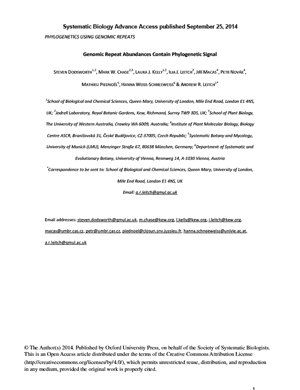NEWS 2014
Genomic Repeat Abundances Contain Phylogenetic Signal
Steven DODSWORTH¹,², Mark W. CHASE²,³, Laura J. KELLY¹,², Ilia J. LEITCH², Jiří MACAS⁴, Petr NOVÁK⁴, Mathieu PIEDNOËL⁵, Hanna WEISS-SCHNEEWEISS⁶, Andrew R. LEITCH¹
Systematic Biology (2014)
doi: 10.1093/sysbio/syu080
¹School of Biological and Chemical Sciences, Queen Mary, University of London, Mile End Road, London E1 4NS, UK
²Jodrell Laboratory, Royal Botanic Gardens, Kew, Richmond, Surrey TW9 3DS, UK
³School of Plant Biology, The University of Western Australia, Crawley WA 6009, Australia
⁴Institute of Plant Molecular Biology, Biology Centre ASCR, Branišovská 31, České Budějovice, CZ-37005, Czech Republic;
⁵Systematic Botany and Mycology, University of Munich (LMU), Menzinger Straße 67, 80638 München, Germany
⁶Department of Systematic and Evolutionary Botany, University of Vienna, Rennweg 14, A-1030 Vienna, Austria
Abstract
A large proportion of genomic information, particularly repetitive elements, is usually ignored when researchers are using next-generation sequencing. Here we demonstrate the usefulness of this repetitive fraction in phylogenetic analyses, utilising comparative graph-based clustering of next-generation sequence reads, which results in abundance estimates of different classes of genomic repeats. Phylogenetic trees are then inferred based on the genome-wide abundance of different repeat types treated as continuously varying characters; such repeats are scattered across chromosomes and in angiosperms can constitute a majority of nuclear genomic DNA. In six diverse examples, five angiosperms and one insect, this method provides generally well supported relationships at interspecific and intergeneric levels that agree with results from more standard phylogenetic analyses of commonly used markers. We propose that this methodology may prove especially useful in groups where there is little genetic differentiation in standard phylogenetic markers. At the same time as providing data for phylogenetic inference, this method additionally yields a wealth of data for comparative studies of genome evolution.

